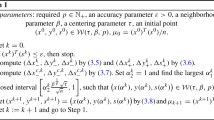Abstract
An algorithm for finding a large feasiblen-dimensional interval for constrained global optimization is presented. Then-dimensional interval is iteratively enlarged about a seed point while maintaining feasibility. An interval subdivision method may be used to check feasibility of the growing box. The resultant feasible interval is constrained to lie within a given level set, thus ensuring it is close to the optimum. The ability to determine such a feasible interval is useful for exploring the neighbourhood of the optimum, and can be practically used in manufacturing considerations. The numerical properties of the algorithm are tested and demonstrated by an example problem.
Similar content being viewed by others
References
G. Alefeld and J. Herzberger,Introduction to Interval Calculations (Academic Press, New York, 1983).
J.H. Bleher, S.M. Rump, U. Kulisch, M. Metzger, Ch. Ullrich and W. Walter,Fortran-sc. A study of aFortran extension for engineering/scientific computation with access toAcrith, Computing 39(1987)93–110.
J.D. Buys and F. Gonin, The use of augmented Lagranian functions for sensitivity analysis in nonlinear programming, Math. Progr. 12(1977)281–284.
T. Csendes, An interval method for bounding level sets of parameter estimation problems, Computing 41(1989)75–86.
T. Csendes, Interval method for bounding level sets: Revisited and tested with global optimization problems, BIT 30(1990)650–657.
T. Csendes and J. Pintér, A new interval method for locating the boundary of level sets, Int. J. Comp. Math. 49(1993)53–59.
A.V. Fiacco, Sensitivity analysis for nonlinear programming using penalty methods, Math. Progr. 12(1976)287–311.
C.A. Floudas and P.M. Pardalos,A Collection of Test Problems for Constrained Global Optimization Algorithms, Lecture Notes in Computer Science 455 (Springer, New York, 1990).
H.-P. Jüllig, BIBINS/2.0 — C++ Bibliotheken für Vektoren und Matrizen über beliebigem skalaren Datentyp unter Berücksichtigung spezieller spärlicher Strukturen sowie Intervalldatentypen, Bericht 92.6, Technical University of Hamburg-Harburg (1992).
R.B. Kearfott, An interval branch and bound algorithm for bound constrained optimization problems, J. Global Optim. 2(1992)259–280.
R. Klatte, U. Kulisch, M. Neaga, D. Ratz and Ch. Ullrich,Pascal-xxc — Language Reference with Examples (Springer, Berlin, 1992).
Z. Kovács, F. Friedler and L.T. Fan, Recycling in a separation process structure, AIChE J. 39(1993)1087–1089.
B.P. Kristinsdottir, Z.B. Zabinsky, T. Csendes and M.E. Tuttle, Methodologies for tolerance intervals, Interval Comp. 3(1993)133–147.
Ch. Lawo, C-XSC — A programming environment for verified scientific computing and numerical data processing, Manuscript, University of Karlsruhe (1991).
K.R. Lutchen and A.C. Jackson, Confidence bounds on respiratory mechanical properties estimated from transfer versus input impedance in humans versus dogs, IEEE Trans. Biomed. Eng. 39(1992)644–651.
P.M. Pardalos and J.B. Rosen,Constrained Global Optimization, Algorithms and Applications, Lecture Notes in Computer Science 268 (Springer, Berlin, 1987).
H. Ratschek and J. Rokne,Computer Methods for the Range of Functions (Ellis Horwood, Chichester, 1984).
H. Ratschek and J. Rokne, Experiments using interval analysis for solving a circuit design problem, J. Global Optim. 3(1993)501–518.
Z.B. Zabinsky, D.L. Graesser, M.E. Tuttle and G.I. Kim, Global optimization of composite laminates using improving hit-and-run, in:Recent Advances in Global Optimization, ed. C.A. Floudas and P.M. Pardalos (Princeton University Press, Princeton, 1992) pp. 343–368.
Author information
Authors and Affiliations
Additional information
This work was supported by Grants OTKA 2879/1991 and OTKA 2675/1991, and in part by NSF Grant DDM-9211001.
Rights and permissions
About this article
Cite this article
Csendes, T., Zabinsky, Z.B. & Kristinsdottir, B.P. Constructing large feasible suboptimal intervals for constrained nonlinear optimization. Ann Oper Res 58, 279–293 (1995). https://doi.org/10.1007/BF02096403
Issue Date:
DOI: https://doi.org/10.1007/BF02096403




